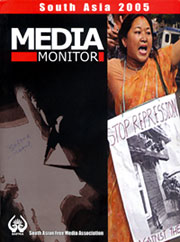 In the post-1990 wave of liberalisation, media in South Asia has multiplied many times. In the place of one or two television stations controlled by the state in each of these countries, now there are dozens of channels with overlapping satellite footprints all over the region and beyond. Cable networks now bring up to 100 channels into livings rooms across the subcontinent. Staid old newspapers that filled their pages with tender notices of government contracts and handouts from press information bureaus have jazzed themselves up to full-colour and respected national dailies have turned into tabloids.
In the post-1990 wave of liberalisation, media in South Asia has multiplied many times. In the place of one or two television stations controlled by the state in each of these countries, now there are dozens of channels with overlapping satellite footprints all over the region and beyond. Cable networks now bring up to 100 channels into livings rooms across the subcontinent. Staid old newspapers that filled their pages with tender notices of government contracts and handouts from press information bureaus have jazzed themselves up to full-colour and respected national dailies have turned into tabloids.
Pop music and chat radio crowd the airwaves with names like Radio Mirchi and Hits FM. Glossy magazines compete in the marketplace with lifestyle supplements in daily papers. Pink papers with pages upon pages of stock market prices are lapped up by upwardly-mobile investors. On the face of it, everything appears to be hunkydory in a region on the rise. But scratch the surface and you encounter the seamier side of South Asian media.
Media Monitor-2005, an annual publication of the Lahore-based South Asia Free Media Association does one better. It scrapes the sheen, and slime, off the media scene to show the different world within in its true colours. The country report for Bangladesh begins with Afsan Chowdhury's report on the 'Most Dangerous Place in the World' for journalists. Bhaskara Rao exposes the obsession of Indian TV channels with trivia and the country report shows that corporate interests have begun to dictate the agenda of the media in India. In the chapter on Pakistan, the case of Amir Mir under the title 'No Buyers of Free Expression' is a damning indictment of media owners who don't hesitate from silencing critics under their umbrella.
The media in Sri Lanka is paranoid, parochial and partisan. Perhaps it's so because it has to operate within a very narrow space, caught as it is in the nutcracker of insurgency and counter-insurgency firepower. Maldives is rightly characterised as a 'prison for journalists' and the overview about Afghanistan is appropriately titled, 'Surviving under Pressure'. It sums up the status of journalists in the entire region.
Grace under pressure, however, becomes the second nature of journalists fighting simultaneously on several fronts. State authorities, non-state militias, drug-dealers, religious bigots, security agencies and shady businessmen are united in their hatred for free media. Nowhere have all these factors been at play as forcefully as upon Nepal's media. The overview of the Nepali media has a self-explanatory title: Press in Chains. Perhaps that is the reason journalists in the faraway plains and mountains of this country have fought hardest to safeguard their freedom.
"If they snatch my ink and pen, / I should not complain, / For I have dipped my fingers / In the blood of my heart." Thus sang Faiz Ahmad Faiz about the intensity with which writers defend freedom. Committed journalists shine brightest in the darkness of the night. Nepal was under the spell of two daunting predators of press freedom-King Gyanendra and Chairman Prachanda. But the media held its ground and have triumphed over the monarch. There is a lesson here for Maoist totalitarianism as well: the Nepali people will never tolerate any future curtailment of freedom. Shooting the messenger is the worst form of politics.
Media doesn't just hold up the mirror to society, it is the mirror. Media monitors almost everyone but there aren't many who monitor the media. SAFMA's effort of self-monitoring is commendable and there is a need for South Asian countries to have national ombudsmen. That said, there is no point in producing such lavish books to document a profession often operating on shoe-string budgets. A humbler production may even remove the necessity of finding Western donors.
CK Lal
Media Monitor South Asia
SAFMA, Lahore, Pakistan.
2005
201 pages


